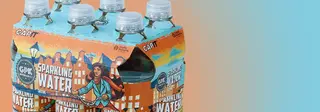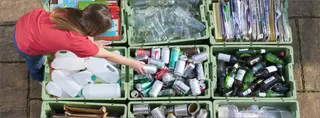
Paper and cardboard are one of the most recycled materials, accounting for two-thirds of what’s recycled in the United States. But that doesn’t mean there isn’t room for improvement—or innovation. Here are just a few of the ways that sustainably minded, forward-thinking companies around the globe are recycling paper to make products that benefit both people and the environment.
The Building Materials Repurposing Waste
“Traditional building materials are destroying our planet,” argues the Barcelona-based startup Honext. The solution? A natural construction material made from water, enzymes and cellulose taken from papermaking’s waste streams. In addition to being 100% recyclable and 100% made from waste, Honext’s material has all the desirable properties of traditional building materials. It’s sound- and thermal-insulating, moisture-resistant, fire-retardant, nontoxic and long-lasting, and it can be cut, drilled and sanded just like wood.
Honext sees waste itself as an untapped resource, and the company is a paradigm of the circular economy. Waste collection leads to materials that build healthy environments, and when Honext’s material eventually reaches the end of its life, it’s recycled and fed back into the circular process to generate new building material. Its value chain stretches from paper mills and waste management companies all the way to architects and construction companies.
The Personal Care Items Made from Paper
Most packaging for personal care items, from toothpaste tubes to deodorant containers, is made with plastic, which most consumers don’t recycle. In the U.S., Procter & Gamble is addressing this problem in a novel way.
The company is committed to 100% recyclable or reusable packaging by 2030. In service to that goal, its brands Old Spice and Secret recently launched all-paper packaging for their aluminum-free deodorants at 500 Walmart stores. The packaging is made with 90% post-consumer recycled content and 10% new paper fibers.
The Company That Wants Every Bottle to Be a Paper Bottle
Paboco, the paper bottle company, wants to replace all plastic packaging, and eventually all glass bottles and metal cans, with paper, the ultimate fully recyclable material made from a renewable resource.
Its earliest bottles were made from recycled newspapers and envelopes, but they’re now made from a refined wood pulp of strong fibers from pine and spruce trees grown in forests managed with sustainable practices. And while its current paper bottles have a barrier layer—the coating separating liquid from paper—made of 100% recycled PET plastic, the next generation’s barrier layer will be bio-based, making the bottle fully recyclable into the paper recycling stream.
L’Óreal, Coca-Cola, Carlsberg and Absolut are already on board with Paboco. The company launched its prototype in Hungary, with 2,000 consumers able to enjoy Coca-Cola’s plant-based drink, AdeZ, from a bottle as natural as its contents.
The Paper Securing Six-Packs
More and more frequently, progressive packaging companies are looking into fiber-based alternatives to the six-pack rings that have been securing cans and bottles since the 1960s.
WestRock’s CanCollar, made of recyclable paperboard, uses 95% less plastic than leading alternatives and includes up to 15% recycled content. Graphic Packaging, meanwhile, offers both the KeelClip, a recyclable paper fastener that replaces plastic rings, and the Cap-It, a recyclable paper clip with neck rings designed to hold plastic bottles.
“With Cap-It, customers are guaranteed a 100% recyclable package that aids the circular economy by providing fibers that can circulate multiple times through the recycling chain and become new packaging,” says Roxanne McSpadden, Graphic Packaging’s director of marketing and beverage new product development.



